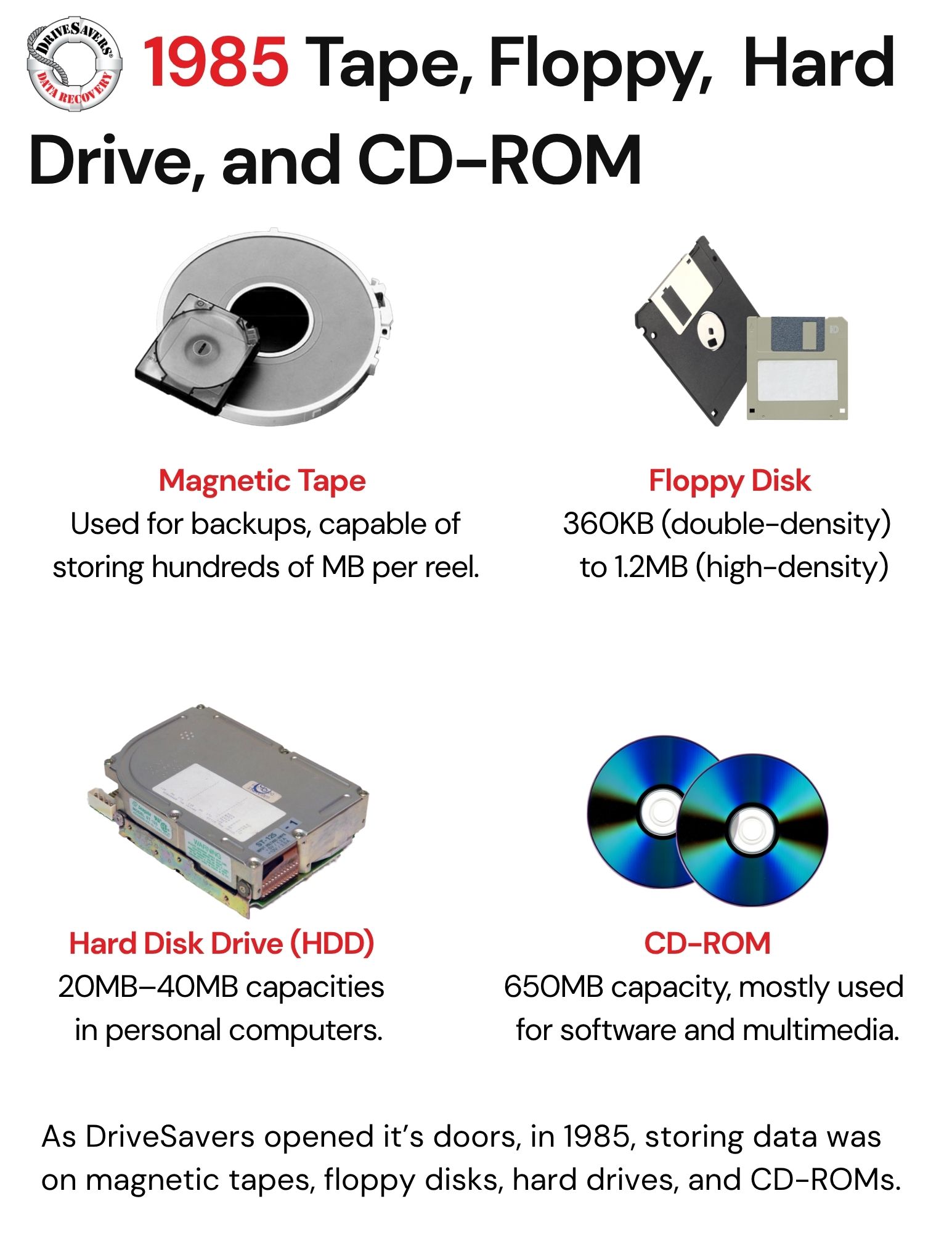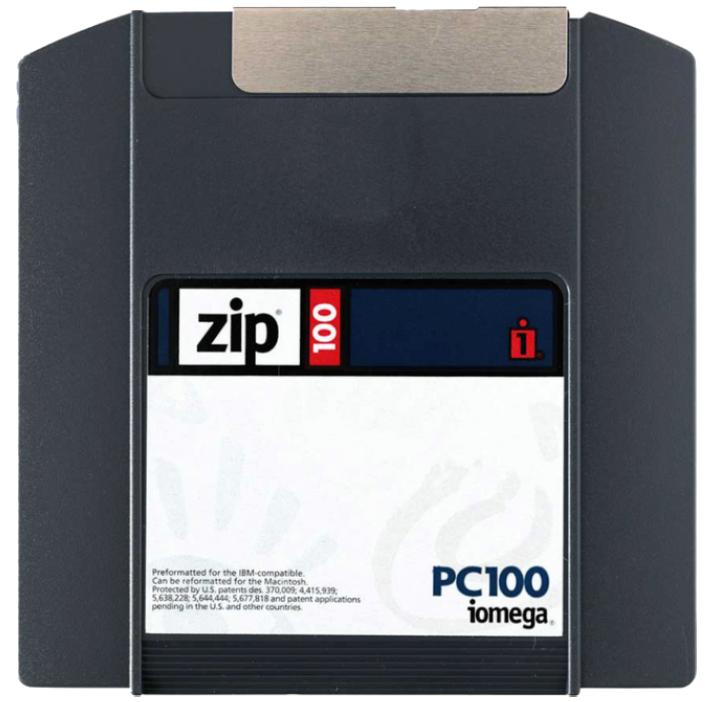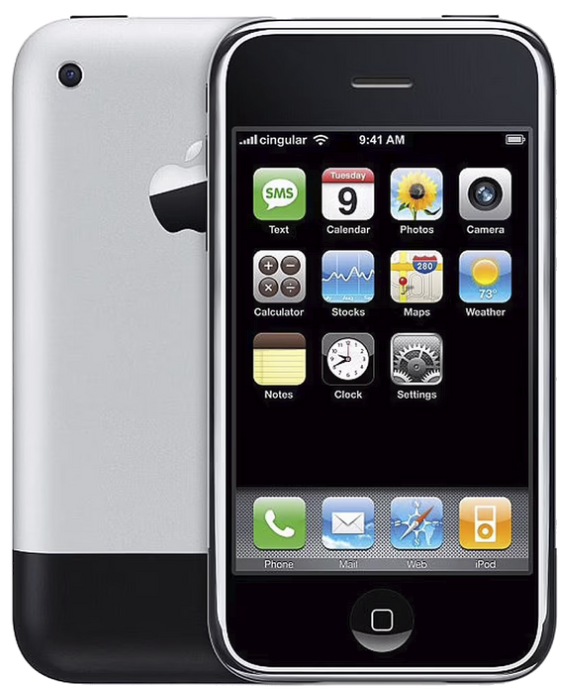Recovering Data From All Storage Devices Since 1985
When DriveSavers opened its doors in 1985, floppy disks were state-of-the-art, hard drives could barely store a photo by today’s standards, and magnetic tape reels were the trusted backbone of enterprise backups.Fast-forward four decades, and we’ve witnessed a remarkable evolution in data storage—from bulky plastic disks to sleek smartphones boasting a terabyte of capacity.
As we celebrate our 40th anniversary, we’re taking a moment to reflect on the extraordinary advances in storage technology. Not only have we recovered data from nearly every format ever created, we’ve had a front-row seat to the entire history of data storage.
Back in the mid-1980s, storing data meant managing bulky and delicate media formats. Magnetic tape was the go-to solution for businesses backing up large volumes of digital data, capable of storing hundreds of megabytes per reel—a major feat at the time.
Floppy disks, though limited in capacity (360KB to 1.2MB), were widely used both at home and in the office. They were portable, easy to use, and perfect for file sharing.
Around the same time, hard disk drives (HDDs) started appearing in personal computers, with capacities ranging from 20MB to 40MB—a revolutionary development.
The arrival of CD-ROMs, with a 650MB capacity, opened a new world of software, games, and multimedia. For the first time, users could install comprehensive programs from a single optical storage disc.


By the 1990s, storage media began evolving quickly. In 1994, Iomega introduced the ZIP disk—a sleek, higher-capacity alternative to the floppy, first offering 100MB, then expanding to 750MB. It became especially popular in creative industries where graphic designers and video editors needed portable storage with extra room.
Then came a true game-changer: the USB flash drive. In 2000, IBM and Trek released an 8MB model that plugged directly into a USB port—no drive bay, no moving parts, just simple plug-and-play storage. Around the same time, the SD card arrived, giving camera and mobile phone users a compact and convenient way to store photos and music.
As digital lifestyles took hold, so did the demand for faster, more compact, and more reliable storage solutions. SATA drives replaced the older IDE standard, offering quicker data transfers. Flash memory became standard in consumer electronics.
Before the iPhone, BlackBerry helped define the mobile data era by enabling access to email and documents on the go. Its widespread enterprise adoption laid the foundation for smartphones as essential tools for work and daily life.
In 2007, Apple launched the first iPhone, featuring up to 16GB of embedded flash storage—a pivotal moment in how we store and carry our digital lives. The next year, Apple introduced the MacBook Air—the first mainstream laptop with a solid-state drive (SSD) instead of a traditional hard drive. SSDs brought faster speeds, greater durability, and higher reliability, and quickly became the new standard.
In enterprise environments, demand for storage continued to rise. In 2013, HGST introduced helium-filled hard drives, which ran cooler, reduced friction, and increased data density—supporting cloud providers and data centres managing massive volumes of information.


Today, storage innovation is defined by one theme: more power in less space. Whether in smartphones, laptops, or massive data centres, modern storage is faster, denser, and more reliable than ever before.
Smartphones now match desktop computers in storage capacity. In 2021, Apple introduced the iPhone 13 Pro with up to 1TB of internal storage. MacBooks with M2 and M3 chips now offer multi-terabyte SSDs in ultra-light machines. Android devices from Google and Samsung offer similar capabilities, and laptops from Dell, Lenovo, and others now rely on high-performance NVMe SSDs. Cloud-native platforms like Chromebooks have further shifted consumer expectations towards seamless, always-available data access.
In the enterprise world, solid-state storage is being adopted for high-performance applications such as AI, analytics, and real-time cloud services—while reducing power usage and physical space requirements.
The next generation of storage is already here, changing not only how much we can store, but also how we interact with our data.
Compact, rugged solid-state drives now deliver desktop-class speed in a travel-friendly form. Professionals can carry multi-terabyte drives in a shirt pocket—complete with encryption, biometric security, and water resistance, once exclusive to enterprise hardware.
Enterprise SSDs are now reaching sizes over 60 terabytes. This breakthrough enables faster AI model training, massive-scale video production, and real-time analytics across industries.
As cyber threats grow more advanced, storage devices are becoming more intelligent—integrating features like fingerprint authentication, secure boot, and real-time encryption directly into the device.
With data centres consuming more energy than ever, manufacturers are embracing low-power designs, recyclable materials, and more efficient architectures—reducing environmental impact while supporting growing storage needs.
One thing is clear through all these advances: data storage is no longer just about space—it’s about speed, mobility, intelligence, and responsibility.
The history of data storage isn’t just a timeline of technical innovation—it’s a story of adaptability and progress. At DriveSavers, every new storage medium has pushed us to develop cutting-edge tools and methods to recover data from increasingly complex systems.
As the world entrusts its memories, creativity, and everyday tasks to digital devices, the demand for expert recovery only continues to grow. From bulky magnetic tapes and fragile floppies to whisper-quiet SSDs and smartphones with terabytes of space—the transformation has been extraordinary.
And through it all, DriveSavers has been there. We’ve recovered data from every format and failure scenario. As we mark 40 years of service, we remain dedicated to leading the future of data recovery.
Here’s to the past, the present—and every byte to come.





